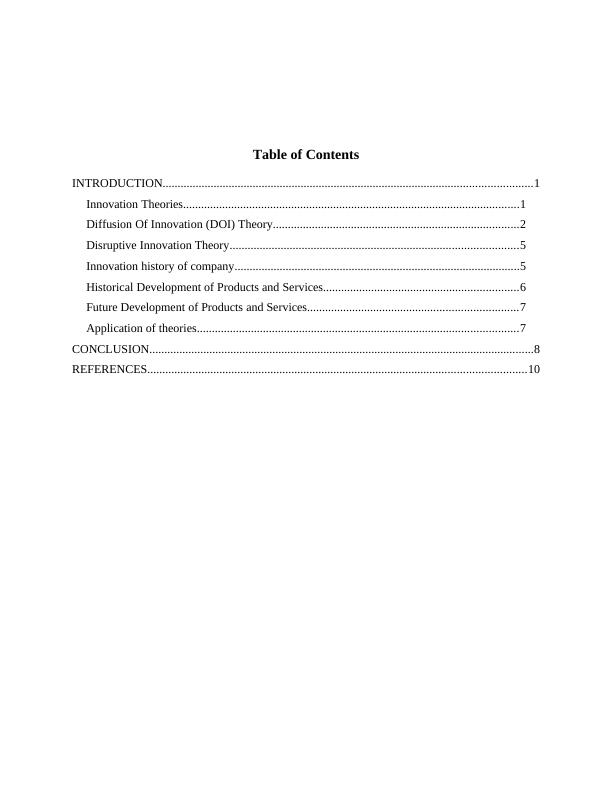(PDF) Managing Innovation in Business - Assignment
12 Pages3792 Words373 Views
Added on 2021-01-02
(PDF) Managing Innovation in Business - Assignment
Added on 2021-01-02
ShareRelated Documents
MANAGINGINNOVATION

Table of ContentsINTRODUCTION...........................................................................................................................1Innovation Theories................................................................................................................1Diffusion Of Innovation (DOI) Theory..................................................................................2Disruptive Innovation Theory................................................................................................5Innovation history of company...............................................................................................5Historical Development of Products and Services.................................................................6Future Development of Products and Services......................................................................7Application of theories...........................................................................................................7CONCLUSION................................................................................................................................8REFERENCES..............................................................................................................................10

INTRODUCTIONInnovation refers to the process of creation of a new product, service, process, technologyor addition of value to existing goods and procedures to serve the needs and demands ofconsumers. It is essential for business enterprises to indulge in innovative practices on a regularbasis so as to receive assistance and recognition from customers, government as well asprofessional bodies (Helper and Henderson, 2014). By bringing in innovations in the form ofproducts or services at frequent intervals, companies strive to build trust and loyalty amongcustomers and retain them for a long duration of time. This report is based upon made.comwhich is a retail brand dealing in furniture and housewares online as well as across a widenetwork of experiential showrooms located within Europe. This enterprise is headquartered inLondon, United Kingdom. It will gain an insight into two innovation theories and its implicationin context of the organisation. Also, the historical as well as future development of goods andservices is discussed.Innovation TheoriesInnovation is one of the most crucial concerns of every company and its role within themarketplace is alienable. This ascertains the extent to which an organisation indulges in creationof a new product or addition of value to existing procedures. Innovation can be brought about interms of product or service development, ways of carrying out work, methods of management oftasks etc. (Noble, 2017). This is an element which strives to provide a strategic edge to anorganisation within the market. Innovation drives the attention of customers towards the range ofnew and unique offerings of enterprise and works towards the growth of business in long run.Besides this, innovation tends to provide satisfaction to customers by way of providing suchproducts and services which can fulfil the needs, demands and requirements of consumers in themarketplace. The need for entity to bring innovative processes and techniques is determined byResearch & Development (R&D) department within the enterprise which keeps on conductingstudy in relation to the latest trends and techniques prevailing within industry (Grandori, 2012).The company then undertakes steps to execute such advanced technologies and proceduresacross the premises to gain recognition in market and retain customers for long duration of time.1

In this regards, various types of innovation theories can be used and implemented by enterprise,some of which are specified below:-Diffusion Of Innovation (DOI) TheoryThis is a theory proposed by E.M. Rogers in the year 1962 and exist as one the mostancient social science theories. It is generally used in the process of communication and exploresthe ways in which an innovative idea or process is communicated by way of utilisation ofvarious channels. There can be a number of ways through which data can be transmitted, rangingfrom interpersonal communication to mass media. Diffusion of Innovation (DOI) theory assistsin determining those aspects which affect the rate at which innovation is adopted by anindividual (Goolsbee and Krueger, 2015). It explores the manner in which an innovation firstgains momentum and then diffuses across a specified population. The end outcome of suchdiffusion is adoption of innovative idea or process. The most crucial aspect of such adoption isthat personnel must be able to perceive the new or modified idea, goods or technology.As per this theory, adoption of innovative idea, technique, product or service does nottake place instantly, instead this is a process which requires the element of time. Here, someindividuals adopt the innovation while others adopt it later. It is generally observed thatindividuals who adopt innovation at an early possess different behavioural characteristics thanthose who adopt it a slower pace. While promoting an innovative practice or process among atarget audience, it is imperative that focus is laid upon the behavioural characteristics ofindividual within such population so as to identify the probable chances of adoption ofinnovation (Dodgson, 2018). According to the philosophy of this theory, there exist five adoptercategories and although majority of the individuals belong to middle categories, yet it is essentialto gain an insight into the traits of target audience. Different strategies are utilised by businessorganisations while appealing to various adopter categories.As per this theory, adopters are defined as “individuals, groups, business entities or largerpopulation prevailing amidst the social system categorised as per their ability to adoptinnovation.” The five adopter categories which are included in Diffusion of Innovation (DOI)theory are described below:-Innovators: These are the individuals which are keen to adopt an innovation and possessan enthusiastic approach towards any new product, process, technology or service. They possess2

End of preview
Want to access all the pages? Upload your documents or become a member.
Related Documents
The Role of Innovation in Zipcar: A Case Studylg...
|16
|4363
|42
Managing Innovation Assignment - AirBnb companylg...
|15
|3689
|232
Managing Innovation: Theories, History, and Future Developmentlg...
|11
|3763
|30
Innovation Management Solution Assignmentlg...
|11
|3215
|26
Theories in Innovation - PDFlg...
|13
|4175
|114
Managing Innovation: Theories and Application in Historical and Future Developmentlg...
|11
|3692
|55
